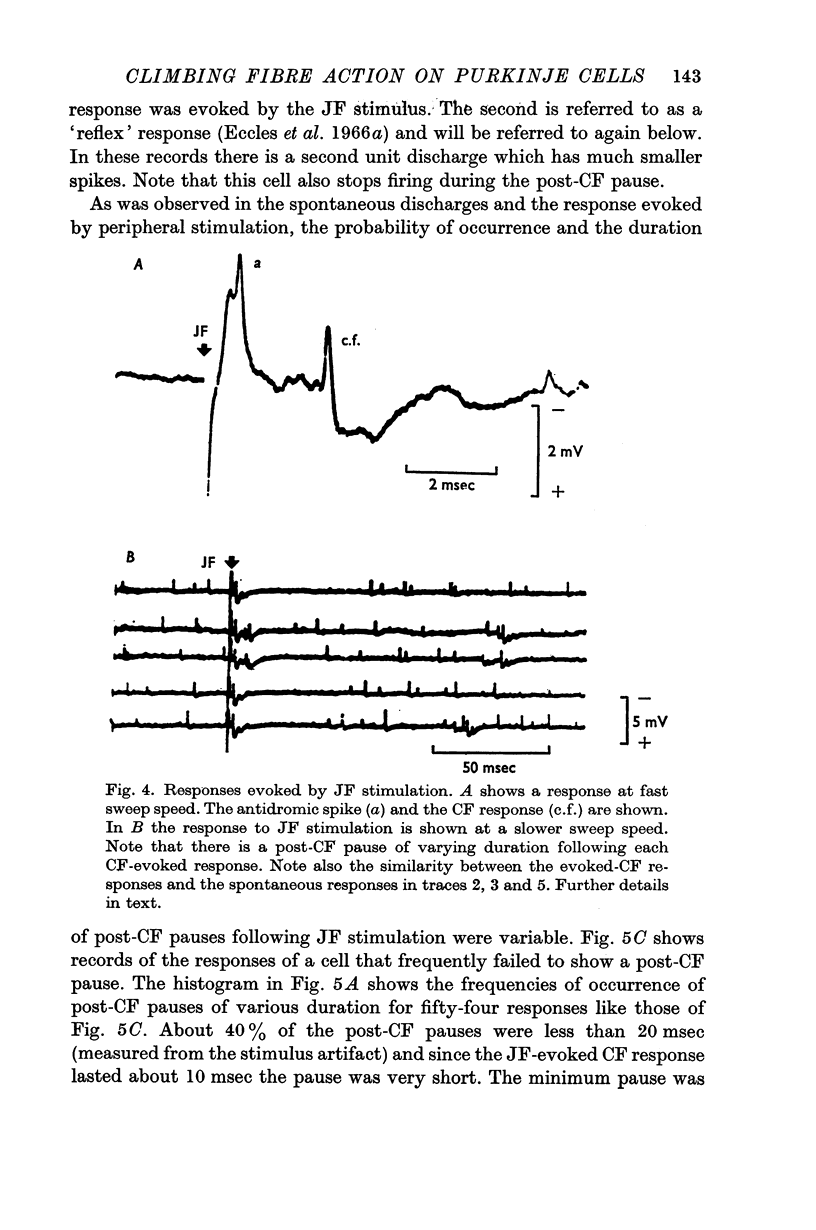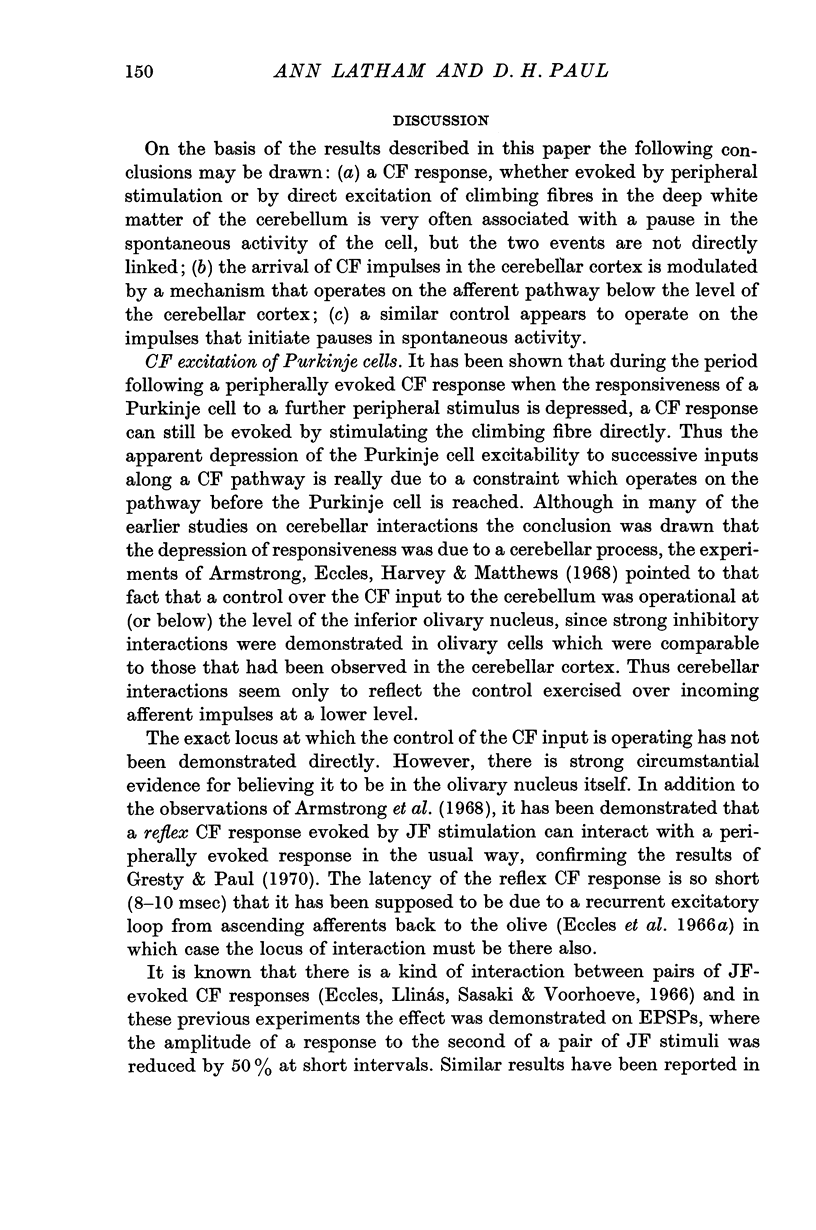Abstract
1. Spontaneous discharges and evoked responses of Purkinje cells have been studied in the anterior lobe vermis of the cerebellum in cats anaesthetized with thiopentone sodium.
2. Spontaneous activity was of two kinds: (a) single spikes which occurred in long trains and were discharged at average frequencies of 50-125/sec and (b) burst responses due to climbing fibre (CF) activation of the cell. These occurred at an average frequency close to 1/sec.
3. CF responses were evoked by either stimulation of the Aβ fibres of the superficial radial nerve (SRN) or by an electrode inserted into the deep white matter near the fastigial nucleus (JF electrode).
4. A suppression of the discharge of single spikes was frequently observed to follow a CF response, whether it occurred naturally or was produced by a stimulus. These pauses in spontaneous discharge (post-CF pause) lasted for approximately 100 msec, but they did not have a one-to-one relationship with the CF responses. Occasionally a pause in the spontaneous activity was elicited by stimuli that failed to evoke the cell.
5. For a period following a peripheral stimulus, a Purkinje cell could not be further excited by a second peripheral stimulus (interaction). JF stimulation could still excite the cell. Evidence was obtained that there was no significant inhibition during the period of depressed excitability to peripheral stimulation.
6. The control over the input of activity to the cerebellum through the CF system appears to be imposed at an extra-cerebellar site. The olivary nuscles was suggested as a strong possibility.
7. Some possible mechanisms responsible for the post-CF pause were discussed. Disfacilitation of Purkinje cells by suppression of granule cell discharges seems to give the best fit to the data.
Full text
PDF





















Selected References
These references are in PubMed. This may not be the complete list of references from this article.
- ALBE-FESSARD D., SZABO T. Observations sur l'interaction des afférences d'origines périphérique et corticale destinées à l'écorce cérébelleuse du chat. J Physiol (Paris) 1954;46(1):225–229. [PubMed] [Google Scholar]
- Armstrong D. M., Eccles J. C., Harvey R. J., Matthews P. B. Responses in the dorsal accessory olive of the cat to stimulation of hind limb afferents. J Physiol. 1968 Jan;194(1):125–145. doi: 10.1113/jphysiol.1968.sp008398. [DOI] [PMC free article] [PubMed] [Google Scholar]
- BREMER F., BONNET V. Convergence et interaction des influx afférents dans l'écorce cérébelleuse, principe fonctionnel du cervelet. J Physiol (Paris) 1951;43(4):665–667. [PubMed] [Google Scholar]
- Bell C. C., Grimm R. J. Discharge properties of Purkinje cells recorded on single and double microelectrodes. J Neurophysiol. 1969 Nov;32(6):1044–1055. doi: 10.1152/jn.1969.32.6.1044. [DOI] [PubMed] [Google Scholar]
- Bloedel J. R., Llinas R. Neuronal interactions in frog cerebellum. J Neurophysiol. 1969 Nov;32(6):871–880. doi: 10.1152/jn.1969.32.6.871. [DOI] [PubMed] [Google Scholar]
- DEURA S., SNIDER R. S. THE INTERACTION OF VARIOUS IMPULSES IN THE CEREBELLUM. J Neurol Sci. 1964 Mar-Apr;1(2):178–196. doi: 10.1016/0022-510x(64)90101-7. [DOI] [PubMed] [Google Scholar]
- Eccles J. C., Llinás R., Sasaki K. Parallel fibre stimulation and the responses induced thereby in the Purkinje cells of the cerebellum. Exp Brain Res. 1966;1(1):17–39. doi: 10.1007/BF00235207. [DOI] [PubMed] [Google Scholar]
- Eccles J. C., Llinás R., Sasaki K. The excitatory synaptic action of climbing fibres on the Purkinje cells of the cerebellum. J Physiol. 1966 Jan;182(2):268–296. doi: 10.1113/jphysiol.1966.sp007824. [DOI] [PMC free article] [PubMed] [Google Scholar]
- Eccles J. C., Llinás R., Sasaki K. The inhibitory interneurones within the cerebellar cortex. Exp Brain Res. 1966;1(1):1–16. doi: 10.1007/BF00235206. [DOI] [PubMed] [Google Scholar]
- Eccles J. C., Llinás R., Sasaki K., Voorhoeve P. E. Interaction experiments on the responses evoked in Purkinje cells by climbing fibres. J Physiol. 1966 Jan;182(2):297–315. doi: 10.1113/jphysiol.1966.sp007825. [DOI] [PMC free article] [PubMed] [Google Scholar]
- Eccles J. C., Provini L., Strata P., Táboríková H. Analysis of electrical potentials evoked in the cerebellar anterior lobe by stimulation of hindlimb and forelimb nerves. Exp Brain Res. 1968;6(3):171–194. doi: 10.1007/BF00235123. [DOI] [PubMed] [Google Scholar]
- FANARDZHYAN V. V. INTERACTION OF AFFERENT SYSTEMS OF THE CEREBELLUM. Fed Proc Transl Suppl. 1963 Sep-Oct;22:982–986. [PubMed] [Google Scholar]
- GRANIT R., PHILLIPS C. G. Excitatory and inhibitory processes acting upon individual Purkinje cells of the cerebellum in cats. J Physiol. 1956 Sep 27;133(3):520–547. doi: 10.1113/jphysiol.1956.sp005606. [DOI] [PMC free article] [PubMed] [Google Scholar]
- Gresty M., Paul D. H. Input-output relations of the inferior olive. J Physiol. 1970 Jun;208(2):92P–93P. [PubMed] [Google Scholar]
- Ito M., Kawai N., Udo M., Sato N. Cerebellar-evoked disinhibition in dorsal Deiters neurones. Exp Brain Res. 1968;6(3):247–264. doi: 10.1007/BF00235127. [DOI] [PubMed] [Google Scholar]
- JANSEN J., Jr Afferent impulses to the cerebellar hemispheres from the cerebral cortex and certain subcortical nuclei; an electroanatomical study in the cat. Acta Physiol Scand Suppl. 1957;41(143):1–99. [PubMed] [Google Scholar]
- Latham A., Paul D. H. Functional properties of a pathway carrying cutaneous afferent impulses from the forelimb to the cerebellar cortex. J Physiol. 1968 May;196(2):132P–133P. [PubMed] [Google Scholar]
- Llinás R., Bloedel J. R. Frog cerebellum: absence of long-term inhibition upon Purkinje cells. Science. 1967 Feb 3;155(3762):601–603. doi: 10.1126/science.155.3762.601. [DOI] [PubMed] [Google Scholar]
- Newman P. P., Paul D. H. The effects of stimulating cutaneous and splanchnic afferents on cerebellar unit discharges. J Physiol. 1966 Dec;187(3):575–582. doi: 10.1113/jphysiol.1966.sp008109. [DOI] [PMC free article] [PubMed] [Google Scholar]
- Newman P. P., Paul D. H. The projection of splanchnic afferents on the cerebellum of the cat. J Physiol. 1969 May;202(1):223–227. doi: 10.1113/jphysiol.1969.sp008806. [DOI] [PMC free article] [PubMed] [Google Scholar]
- Oscarsson O. Termination and functional organization of a dorsal spino-olivocerebellar path. Brain Res. 1967 Aug;5(4):531–534. doi: 10.1016/0006-8993(67)90029-7. [DOI] [PubMed] [Google Scholar]
- SCHEIBEL M. E., SCHEIBEL A. B. Observations on the intracortical relations of the climbing fibers of the cerebellum; a Golgi study. J Comp Neurol. 1954 Dec;101(3):733–763. doi: 10.1002/cne.901010305. [DOI] [PubMed] [Google Scholar]
- Talbott R. E., Towe A. L., Kennedy T. T. Physiological and histological classification of cerebellar neurons in chloralose-anesthetized cats. Exp Neurol. 1967 Sep;19(1):46–64. doi: 10.1016/0014-4886(67)90006-4. [DOI] [PubMed] [Google Scholar]
- Thach W. T., Jr Somatosensory receptive fields of single units in cat cerebellar cortex. J Neurophysiol. 1967 Jul;30(4):675–696. doi: 10.1152/jn.1967.30.4.675. [DOI] [PubMed] [Google Scholar]


